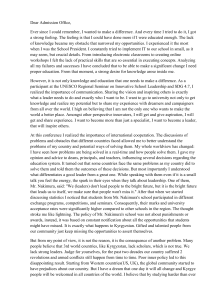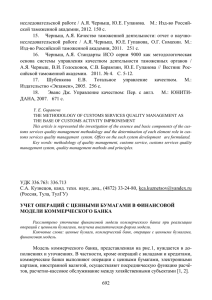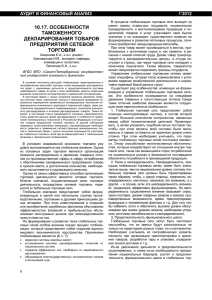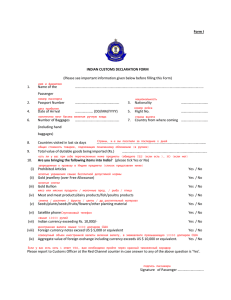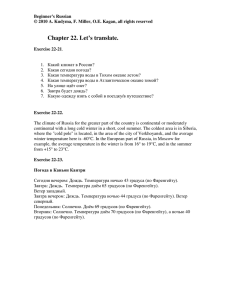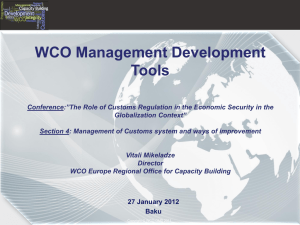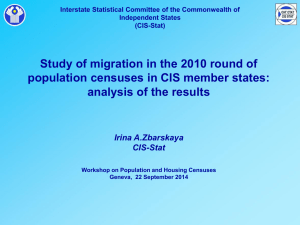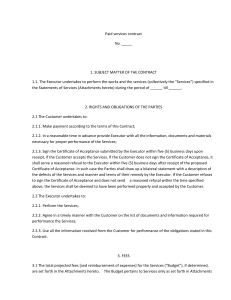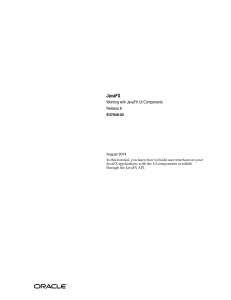Tariff Level of the Customs Union
реклама
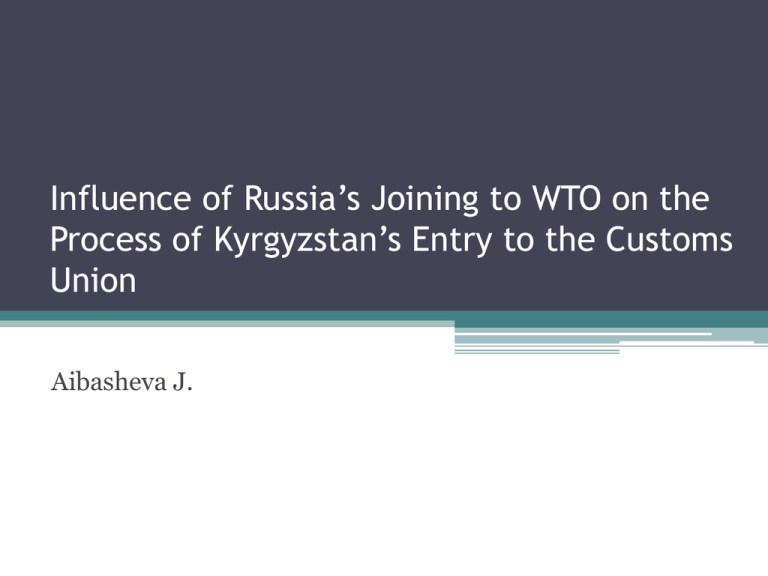
Influence of Russia’s Joining to WTO on the Process of Kyrgyzstan’s Entry to the Customs Union Aibasheva J. What has Kyrgyzstan Received Joining to WTO? • It has provided the secure and predictable international trade of goods, services and capital for business community; • Continuation of the trade liberalization process; • Influence on conducting of the regulatory reforms; • Principal changes in foreign trade regime and geographical trade distribution; • Liberal trade regime has given rise to the growth of foreign trade turnover volumes by 4.8 time to increase from USD 1,355.1 million in 1998 to USD 6,488.6 million in 2011, export - from USD 513.6 to 2,239.8 million, and import - from USD 841.5 to 4,248.8 million. (Fig.1. and 2.) Foreign Trade Trend of Kyrgyzstan in 1998-2011 7000 6000 5000 Mln.USD 4000 3000 2000 1000 0 -1000 -2000 -3000 1998 1999 2000 2001 2002 trade turnover 2003 2004 export 2005 import 2006 2007 balance 2008 2009 2010 2011 Fig.2. Structure of Goods Turnover of Kyrgyzstan with the WTO countries 3392.8 3500 3000 2664 2500 2547 2304.7 2000 2198.9 1877.2 1588 1500 1407.8 1326.2 1052.5 1000 606.9 500 548.2 348.7 259.2 0 471.6 303 245.2 253 432.8 218.6 154 278.8 686.9 567.5 260.2 307.3 780.5 763.8 719.3 412.6 350.5 306.5 430 380.4 351.2 333.2 73.9 47.1 34.4 79.5 124.8 -89.5 -57.8 -61.4 1998 1999 2000 2001 2002 2003 2004 2005 2006 786.8 2007 2008 -450.8 -1090.4 -1500 экспорт импорт сальдо 2009 -510.9 -1000 Товарооборот 896.9 958.6 437.7 -386.1 -500 1193.9 888.5 2010 2011 -629.4 -1005 What has Kyrgyzstan Received Joining to WTO? • In 2011, the trade of Kyrgyzstan is represented by more than 120 countries: by import - 123, export -78 (in 1998 - 98 countries); • Expansion of trade geography has occurred due to the fact that Kyrgyz export is used by RNB in all member countries of WTO; • The growth of economy openness; in 2011 the openness of economy reached 142.4 % to GDP, including export-57.1%, import-85.3% How will Kyrgyzstan benefit from Russia’s entry to WTO? • First, the trade and economic legislation will be in a single legal framework; • Second, Russia’s entry to WTO mitigates the problems and risks considered to be inadmissible in case of Kyrgyzstan’s entry to the Customs Union (Kyrgyzstan submitted its request to enter the CU on 19.10.2011 in Saint-Petersburg at the meeting of heads of EurAsEC). Russia’s entry to WTO allows solving the issue whether Kyrgyzstan, having obligations to the WTO members - considerably low tariffs can enter the Customs Union, where these tariffs are a sequence higher Regulation of WTO on Regional Agreements • According to WTO Regulations it is allowed to create regional agreements observing 2 conditions: 1) they shall promote the trade with regular WTO members and shall not create barriers for the trade with other countries; 2) customs tariffs shall not be generally higher, than customs tariffs of WTO; in case if these conditions are not implemented, the external WTO members shall receive compensation. • It should be noted that yet initially the import tariffs of Kyrgyzstan were lower, than tariffs of our CIS neighbors, these are unified 10% tariffs before entering to WTO and already differentiated tariffs after entering (Table 1) Obligations of Kyrgyzstan and Russia in WTO on Customs Duties for Goods CCT (until 25.08.12) All goods list agricultural products manufactured goods of Obligations of Russia in WTO Obligations of Kyrgyzstan in WTO Initial level Final level Average associated Applied 10.3 11.8 7.7 7.4 5.0 15.6 15.2 11.3 12.2 8.1 9.4 11.3 6.1 6.5 4.1 Tariff Obligations of Russia on Goods • It is seen from Table 1 that by the end of the transition period the customs tariffs of Russia will be significantly decreased from 11.8% to 7.7 %. But at the same time it will preserve high values by a range of goods – engineering products and softgoods intended to be developed by the country; • The Russian final level of the customs tariff (after the transition period) will be at the level of our associated tariff which means that we can without serious consequences increase the level of the customs tariff up to the associated level without resorting to compensation for the increase Level of Tariffs on Some Goods Denomination of Goods Obligations of Russia in WTO Initial level Final level Obligations of Kyrgyzstan in WTO Average Applied associated 10 10 15 15 10 10 10 10 10 10 10 10 10 CPF 10 CPF 10 10 10 10 Beef Milk Butter Cheese Wheat Rice Plastic fabric Synthetic tissue New light vehicle Light vehicle used more than 5 years New trucks Trucks used more than 5 years 25 25 20 20 5 25 10 10 25 25 15 15 15 15 5 10 8 10 5 20 10 15 10 10 10 10 10 New tractors 15 10 10 0 Why do We Orient on the Level of Customs Duties of Russia? • After beginning of the Customs Union functioning a part of powers on regulation of the trade has transferred to the supernational level, Russia has taken the obligations on provision of implementation of WTO requirements and at the level of the Customs Union; • Finally Russia has taken two obligations; • First: within CU (and, apparently, CES) the RF will not take any obligations violating the WTO regulations; • Second: Russia essentially will be an agent of WTO in CU as it has undertaken to transfer to CU when discussing “considerations on proposals” on the part of WTO members it agreed with Tariff Level of the Customs Union • Since 25.08.12 the CU has decreased tariffs. Herewith, import duties by 90% are preserved at the same level. According to the preliminary calculations, when transferring to the revised version of CCT the average weighted rate of import customs duty will make 7.5-7.8%; • The major changes of tariffs occurred for food products and other consumer goods (in part of food stuffs they will more intensely affect meat and milk groups, as well as some kinds of vegetables and fruits); • In compliance with the Agreement on WTO it is also envisaged to gradually decrease duties for the major part of textile production, including clothes Comparison of Average Duty Levels of KR and RF • As a result of comparison of the consolidated customs tariff of KR and final customs tariff of RF on the obligations in WTO (by 6-point list of goods of FTNG, by 5052 sub-item, 97 goods groups) it has been established that the overall average of KR is 7.4 %, and RF -7.7 % for ad valorem duties there are: • - 1454 sub-items, where the average value of KR is lower than the average of RF (29%); • -1083 sub-items, where the average value of KR is equal to the average of RF (21.4%); • - 2001 sub-items, where the average value of KR is higher than the average of RF (39.6%); • - 514 sub-items with non-ad valorem tariff lines (10.2%) Comparison of Average Duty Levels of KR and RF • List 1. List of sensitive items of KR, the average rates of consolidated customs duties of which are lower than the average rates of RF; • This list of goods is rather sensitive for the Republic as the changes of tariff rates shall increase, and this will require the relevant changing of tariff rates accepted within the frame of WTO. • List 2. List of sensitive items of KR, the average rates of consolidated customs duties of which are higher than the average rates of RF; • Changes of duty rates by this list will not require changing of obligations of KR to WTO. But these changes can reflect on the competitiveness of goods made in the Republic, that is why it will be required to conduct consultations with the domestic producers List of Sensitive Items of KR • The draft of KR proposals for negotiations on joining to the CU “List of goods and rates, in which relation within the transition period of KR it is required to apply rates of import customs duties differing the rates established by the Common Customs Tariff of the CU” has been prepared based on List 1 and 2. This draft of list covers for the time being 128 goods items, where sensitive goods supplied from the countries of the Customs Union and CIS countries have not been included Issue on Compensation in Case of Changing of Kyrgyzstan’s Obligations • Former Deputy General Director of WTO, currently Senior Counselor at Courdes Comptes - Paris (French Accounts Chamber) – Paul-Henri Ravier said that the rules had tangled insomuch that allowed some countries to participate not only in two, but in three-four agreements without any compensations; • If Kyrgyzstan is forced, joining to the CU, to increase customs duties, then in this case the increase of rates on goods imported from China and Turkey is being expected, and it can result in the act of protest on the part of these countries, they may claim compensation Conclusion • Kyrgyzstan has obligations in WTO differing from those to which we shall abide becoming a member of the CU. Basically, these are the issues of tariff regulation and sphere of technical and sanitary barriers; • Entering of Russia to WTO has mitigated the problems of tariff regulation of Kyrgyzstan (the CU has already reconsidered the tariffs to the part of decrease); • Kazakhstan and Belorussia are also conducting negotiations with the WTO members on joining to WTO. The CU tariffs will be twice changed, and the CU members will have to accept customs tariffs of that country agreed with WTO on their minimum values or develop from the minimum values of customs tariffs of the countries; • That is why it is more profitable for Kyrgyzstan to enter the CU after all CU members join WTO
